|
|
 |
|
Calanoida ( Order ) |
|
|
|
Diaptomoidea ( Superfamily ) |
|
|
|
Pontellidae ( Family ) |
|
|
|
Calanopia ( Genus ) |
|
|
| |
Calanopia americana F. Dahl, 1894 (F,M) | |
| | | | | | | Ref.: | | | Dahl, 1894 c (p.21, figs.F,M); Giesbrecht & Schmeil, 1898 (p.132, Rem. F,M); A. Scott, 1909 (p.181, figs.F,M); Esterly, 1911 b (p.222, figs.F,M); T. Scott, 1912 (1913) (p.537, Rem., figs.1-6: F,M); Farran, 1929 (p.210, 274); Jespersen, 1940 (p.67); Wilson, 1942 a (p.172, fig.F); Carvalho, 1952 a (p.149, figs.F); Gonzalez & Bowman, 1965 (p.254, figs.F,M, Rem.); Owre & Foyo, 1967 (p.96, figs.F,M); Silas & Pillai, 1976 (p.773); Björnberg & al., 1981 (p.659, figs.F,M); Chen & Marcus, 1997 (p.587, Rem: egg); Bradford-Grieve & al., 1999 (p.885, 958, figs.F,M) | 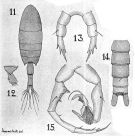 issued from : A. Scott in Siboga-Expedition, 1909, XIX a. [Plate XLVIII, Figs.11-15]. Female (from Bermuda Islands): 11, habitus (dorsal); 12, last thoracic and genital segments (left side); 13, P5. Male: 14, urosome (dorsal); 15, P5.
|
 issued from T.E. Bowman in Proc. U.S. Nat. Mus., 1957, 107 (3382). [p.43, Fig.3, h]. Female: P5.
|
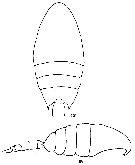 issued from : C.O. Esterly in Proc. Am. Acad. Arts Sci., 1911, 47 (7). [Pl.2, Figs.12, 15]. Female (from Bermuda Is.: Agar's Island): 12, cephalothorax and part of genital segment (dorsal). Male: 15, habitus (lateral).
|
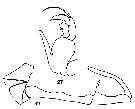 issued from : C.O. Esterly in Proc. Am. Acad. Arts Sci., 1911, 47 (7). [Pl.3, Figs.27, 32]. Male: 27, two terminal segments of right P5; 32, the grasping portion of right A1.
|
 issued from : C.O. Esterly in Proc. Am. Acad. Arts Sci., 1911, 47 (7). [Pl.4, Fig.39]. Female: P5.
|
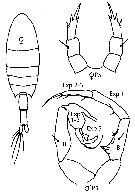 Issued from : J.M. Bradford-Grieve, E.L. Markhaseva, C.E.F. Rocha & B. Abiahy in South Atlantic Zooplankton, edit. D. Boltovskoy. 1999, Vol. 2, Copepoda; [p.1066, Fig.7.378: Calanopia americana]. r = right leg; l = left leg; B = basis; Exp1-2 = exopodal segments 1-2; Exp 3 = exopodal segment 3. Female characters (from key, p.958): - P5 with 1 segment distal to basis. - P5 terminal segment trifid distally, middle point longest. Male characters (from key, p.958): - Distinct 'thumb' present on right P5 exopodal segment 1-2. - Distal border of right P5 basis extends beyond distal border of left leg basis.
|
 Calanopia americana Calanopia americana. Female: 1 - P5 exopod 1-segmented. 2 - Exopod of P5 with 4 spines. 3 - Exopodal segment of P5 with 2 subequal lateral spines and 1 terminal long spine (nearly as long as segment); Male: 1 - Left P5 longer than right one; basis of left P5 swollen proximally. 2 - 2nd exopodal segment of right P5 nearly 2/3 length of 1st exopodal segment; coxa of right P5 about 1.7 times as long as basis. 3 - Basis of left P5 swollen proximally and produced into a prominent tooth-like process, 2nd exopodal segment long; 2nd exopodal segment of right P5 with a deep incision at the base of the thumb; 3rd exopodal segment of right P5 with a distinct medial process.
| | | | | Compl. Ref.: | | | Sewell, 1948 (p.452); C.B. Wilson, 1950 (p.174); Chiba & al., 1957 (p.308); Fish, 1962 (p.17); Gaudy, 1963 (p.28, Rem.)); Björnberg, 1963 (p.58, Rem.); Park, 1970 (p.478); Deevey, 1971 (p.224); Deevey & Brooks, 1977 (p.156, tab.2, Station "S"); Turner & al., 1979 (p.289, 293, Tab.3, Rem.); Turner & Collard, 1980 (p.527, Tab.1); Valentin & al., 1986 (p.117, Table V); Lindo, 1991 (tab.3); Suarez & Gasca, 1991 (tab.2); Suarez, 1992 (App.1); Suarez Morales, 1994 b (tab.1); Webber & al., 1996 (tab.1); Marcus, 1996 (p.144); Suarez-Morales & Gasca, 1997 (p.1525); Lopes & al., 1998 (p.195); Alvarez-Cadena & al., 1998 (tab.1,2,3,4); Suarez-Morales, 1998 (p.345, Table 1); Suarez-Morales & Gasca, 1998 a (p.110); Mauchline, 1998 (tab.40); Lopes & al., 1999 (p.215, tab.1); Neumann-Leitao & al., 1999 (p.153, tab.2); Lopez-Salgado & al., 2000 (tab.1); Cohen & Forward, 2002 (p.307); Uysal & al., 2002 (p.17, tab.1); Dunbar & Webber, 2003 (tab.1); Dias & Bonecker, 2005 (p.100 + poster); Camisotti & al., 2005 (p.99); Cohen & Fordward, 2005 (p.1269, vertical migration vs light intensity vs predator); 2005 a (p.387); 2005b (p.399); Choi & al., 2005 (p.710: Tab.III); Sterza & Fernades, 2006 (p.95, Table 1, occurrence); Dias & Araujo, 2006 (p.69, Rem., chart); Neumann-Leitao & al., 2008 (p.799: Tab.II, fig.6); Morales-Ramirez & Suarez-Morales, 2008 (p.514); Magalhaes & al., 2009 (p.187, Table 1, %); Miyashita & al., 2009 (p.815, Tabl.II); Cornils & al., 2010 (p.2076, Table 3); Medellin-Mora & Navas S., 2010 (p.265, Tab. 2); Magris & al., 2011 (p.260, abundance, interannual variability); Costa R.G. da & al., 2011 (p.364, Table 1, seasonal occurrence); Uysal & Shmeleva, 2012 (p.909, Table I, Rem.: p.927); Almeida LR. & al., 2012 (p.13, Table 1, abundance); Bonecker & a., 2014 (p.445, Table II: frequency, horizontal & vertical distributions); Dias & al., 2015 (p.483, Table 2, abundance, biomass, production); Araujo & al., 2016 (p.1, Table 3, abundance, %) ; Marques-Rojas & Zoppi de Roa, 2017 (p.495, Table 1); Atique & al., 2017 (p.1, Table 1). | | | | NZ: | 6 | | |
|
Distribution map of Calanopia americana by geographical zones
|
| | | | | | | | |  issued from : H.B. Owre & M. Foyo in Fauna Caribaea, 1, Crustacea, 1: Copepoda. Copepods of the Florida Current. 1967. [p.96, Table 45]. issued from : H.B. Owre & M. Foyo in Fauna Caribaea, 1, Crustacea, 1: Copepoda. Copepods of the Florida Current. 1967. [p.96, Table 45].
Vertical distribution of Calanopia americana at the ''40-Mile station'' in the Florida Current (± 25°35'N, 79°27'W).
SL 53: 18 V 1958. A: during midday; B;: during midnight. |
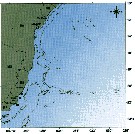 issued from : C. de O. Dias & A.V. Araujo in Atlas Zoopl. reg. central da Zona Econ. exclus. brasileira, S.L. Costa Bonecker (Edit), 2006, Série Livros 21. [p.69]. issued from : C. de O. Dias & A.V. Araujo in Atlas Zoopl. reg. central da Zona Econ. exclus. brasileira, S.L. Costa Bonecker (Edit), 2006, Série Livros 21. [p.69].
Chart of occurrence in Brazilian waters (sampling between 22°-23° S).
Nota: sampling 8 specimens. |
| | | | Loc: | | | Brazil (S, Cabo Frio, Vitoria-Cabo de Sao Tomé, Camamu, Guarairas Lagoon, Mucuri estuary, off Natal, Caeté Estuary, Amazon, Mouth of Tocantin, Rio de Janeiro, Campos Basin, Vitoria Bay, Paranagua, Curuça estuary, Ajuruteua Bay), Barbada Is., Caribbean Colombia, E Yucatan, Venezuela, Bahia de Mochima, Caribbean Sea (Yucatan: Chetumal Bay), Jamaica (Kinsgston Harbour), E Costa Rica, G. of Mexico, Cuba, Florida, North Carolina, Beaufort Inlet, off Bermuda: Station ‘’ S’’ (32°10’N, 64°30’W), Sargasso Sea, off S Cape Hatteras, S Iceland, Medit. (N Lebanon Basin) , Indian (in Chiba & al., 1957), Indonesia (SW Celebes), Philippines (in C.B. Wilson, 1950) | | | | N: | 70 | | | | Lg.: | | | (5) F: 1,3; M: 1,23; (146) F: 1,4; M: 1,3-1,2; (179) F:1,6-1,4; M: 1,4; (237) F: 1,5; M: 1,4; (388) F: 2,1-1,95; (785) F: 1,4; {F: 1,30-2,10; M: 1,20-1,40} | | | | Rem.: | epipelagic. Coastal. Overall depth Range in Sargasso Sea: 0-500 m (Deevey & Brooks, 1977, Station "S");
After Björnberg (1963, p.58) this species was described from waters taken off the mouth of the Amazon River by F. Dahl (1894) with surface salinity 11.8, 35.9 and 36.4 p.1000); off the Brazilian coast it is among the characteristic copepods of shelf waters with salinities 35.00 to 36.00 p.1000.
Observed in ballast waters from ships in San Francisco.
El-Sherbiny & Al-Aidaroos (2017) underline that both exogenous light signals and endogenous rhythms could be the main factors controlling the twilight of the diel vertical migration pattern (Cohen & Forward, 2005). | | | Last update : 12/02/2021 | |
|
|
 Any use of this site for a publication will be mentioned with the following reference : Any use of this site for a publication will be mentioned with the following reference :
Razouls C., Desreumaux N., Kouwenberg J. and de Bovée F., 2005-2025. - Biodiversity of Marine Planktonic Copepods (morphology, geographical distribution and biological data). Sorbonne University, CNRS. Available at http://copepodes.obs-banyuls.fr/en [Accessed November 30, 2025] © copyright 2005-2025 Sorbonne University, CNRS
|
|
 |
 |











